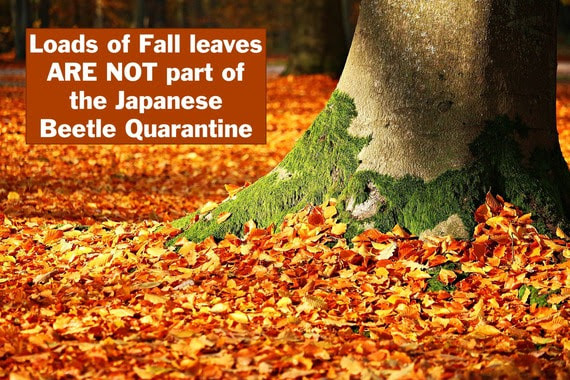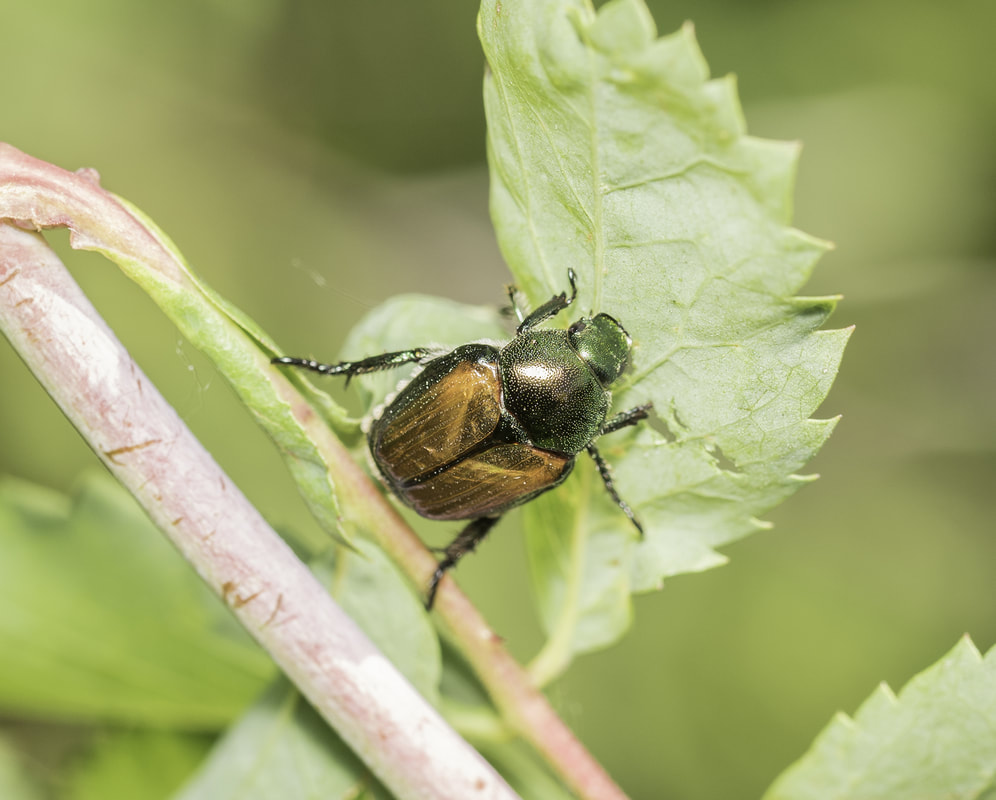|
Community Open House
Two drop-in style, open house's will be held this winter. The first event will take place at Meadow Park Middle School, from 5pm to 7pm Tuesday, February 12th. The second event will be held at the Cedar Mill Public Library, from 1pm to 3pm Saturday, February 22nd. Experts will be ready to answer your questions about the Japanese beetle project. Loads of fall leaves DO NOT need to be taken to the Japanese beetle yard debris drop off site in Hillsboro. Loads of fallen leaves are not a risk to spread Japanese beetle and are not part of the quarantined material. Please see the list below for material that falls within the quarantine. The yard debris quarantine is intended to prevent the spread of Japanese beetle in Oregon and to ensure the success of the current eradication program. The quarantine went into effect in Summer of 2017 and is still active through 2018. The boundary of the quarantine was expanded because of increased Japanese beetle detections in the county in 2017. The Oregon Department of Agriculture is asking all residents, landscapers, and waste managers that work in the yard debris quarantine area to adhere to the information below in order to comply with the quarantine to prevent the spread of both Japanese beetle adults and larvae:
Quarantined yard debris and material:
Not necessary or acceptable materials:
Note:
[TAGS: Washington County, Gardeners, Quarantine, Residents, Yard debris, Landscapers, Northwest Landscaping Services, Updates, Beetles in Oregon] PLEASE NOTE: THIS POST IS AN ARCHIVE FROM THE 2017-2018 PROJECT YEAR. Japanese beetles were first observed in Washington county in 2016. Subsequent trapping and risk modeling has determined that certain areas have a particularly high number of beetles that may hitchhike out of the area on high risk yard debris. To aid in successful eradication, Oregon Department of Agriculture (ODA) is working to contain the Japanese beetle population to a limited and manageable area. ODA has enacted a yard debris quarantine as part of a multi-pronged approach to eradicate the Japanese beetle from Oregon. This quarantine minimizes their spread to other areas in the region by restricting where and how yard debris from inside the quarantine area is transported and processed. Two key containment strategies have been implemented: 1) yard debris in household curbside bins are covered and hauled directly to deep burial at the landfill and 2) yard debris picked up by landscapers is directed to be covered and transported directly to a designated yard debris drop-off site at Northwest Landscape Services, 1800 NW Cornelius Pass Rd, Hillsboro, OR. In 2017, approximately 2,000 tons of yard debris were successfully moved into a special deep burial zone at the Hillsboro landfill where Japanese beetles within the material cannot escape. Why a yard debris drop-off site outside of the quarantine area? The Oregon Department of Agriculture, Oregon Department of Environmental Quality, Metro and Washington County worked closely and deliberated over site locations. They ultimately chose this site for a few well-planned reasons. First, the site was chosen as the lowest risk site. This means that the site has the ability to manage the amount of material transferred and has the lowest risk of spreading beetles to other areas through re-sale of compost, recycled soil, or other mechanisms. Additionally, this drop-off site is in the same county where the population exists, Washington County, and is in near other commonly used yard debris drop-off sites reducing the burden on the landscapers or homeowners. Explore the interactive map with both the boundary of the quarantine area and treatment area, here. What happens at the drop-off site? This is a FREE service for those with material from the quarantine area. The time the material sits at the drop-off site is kept short in order to minimize the chance of beetles escaping and re-establishing in the area. Each load is then moved to a deep burial site in the Hillsboro Landfill to join the curbside yard debris from the quarantine area that is picked up by garbage haulers. Project partners monitor the quarantined yard debris to ensure proper disposal of material. When residents and landscapers comply with ODA regulations, they are more likely to succeed in protection of Oregon’s agriculture and natural resources. "Washington County is the area that is going to benefit the greatest from us being able to do the eradication,” said Clint Burfitt, manager of the Insect Pest Prevention & Management Program for the Oregon Department of Agriculture. For Washington County residents, landscapers, and others involved, the simple act of following quarantine instructions has a hefty ripple effect. If this Japanese beetle population can be successfully eradicated through these early efforts, the costs accumulated, resources used, and negative impacts of this project will stay exponentially lower than if they became established. A big thank you to all of the residents, landscapers, and other folks from within the quarantine area for continuing to make this project a success! Please do not hesitate to contact ODA with any questions or concerns by calling 1-800-525-0137 or emailing the project coordinator Chris Hedstrom at [email protected]. Beetles can be moved in yard debris through the removal and movement of items such as sod and grass clippings. The risk of moving beetles is highest over the summer when adult beetles are emerging from the soil and moving around to feed and find mates. It is very important that beetles are contained within Washington County while treatment takes effect. Containment efforts are ramping up, with a quarantine on all yard debris still in effect and expanding in 2018. Residences will receive electronic notices from Oregon Department of Agriculture, along with other communications planned throughout the summer.
For more information about the quarantine check back on our Prevention page for the most recent information. [TAGS: Beetles in Oregon, Japanese beetle basics, Japanese beetle threat, Invasive species, Gardeners, Quarantine, Residents, Landscapers, Washington County, Yard debris] PLEASE NOTE: THIS POST IS AN ARCHIVE FROM 2017. Below is a sample of the plant damage that has been seen in the Cedar Mill area in the summer of 2017 as a result of the infestation of Japanese beetles. Damage on Rosa sp. from the Japanese Beetle. Photograph by Oregon Department of Agriculture. Japanese beetle caught feeding on a flower. Photograph by Oregon Department of Agriculture. Live beetle bites into unidentified plant leaf. Photograph by Oregon Department of Agriculture.
PLEASE NOTE: THIS POST IS AN ARCHIVE FROM 2017. In order to keep Japanese beetle from spreading while the adults are actively feeding and breeding aboveground, the ODA has established a yard debris quarantine in the area of Cedar Mill and Bethany. As part of the quarantine, residential yard debris including grass clippings, plants with soil, and sod must be contained and placed in curbside yard debris bins or transported directly to the drop off site at Northwest Landscape Services. Compost and transfer facilities are not allowed to accept yard debris from the quarantine area. These containment efforts are necessary to keep the infestation from spreading by way of current waste management practices. To learn more, please visit our Prevention page.
|
Header photograph by Whitney Cranshaw, bugwood.org
Categories
All
Archives
January 2024
|
|
This website is intended to provide readers with information that has been peer reviewed and produced from transparent and accountable sources. The Oregon Department of Agriculture is the lead agency for this project and maintains this website.
|
© COPYRIGHT 2018. ALL RIGHTS RESERVED.










 RSS Feed
RSS Feed
